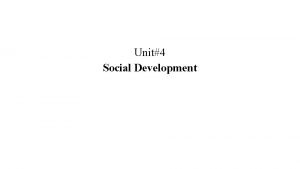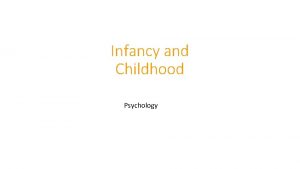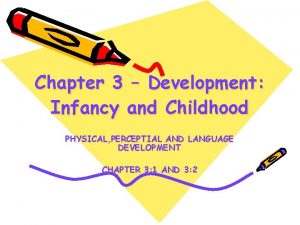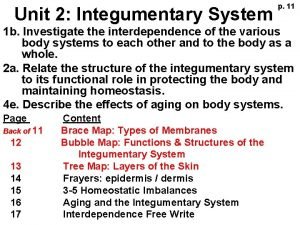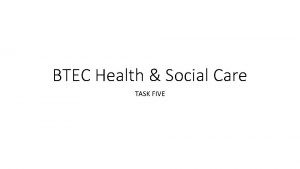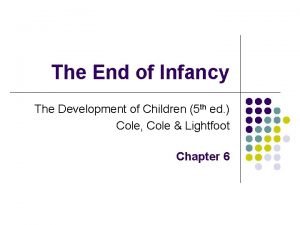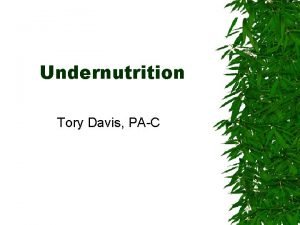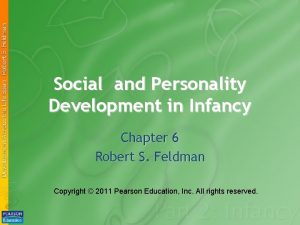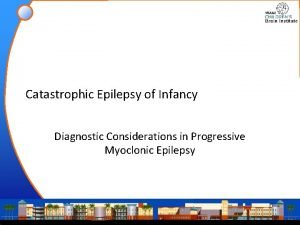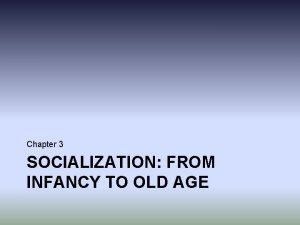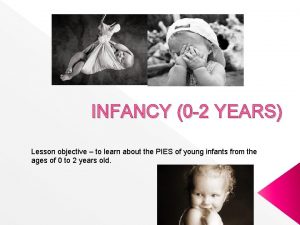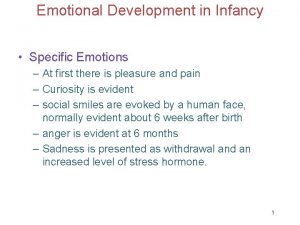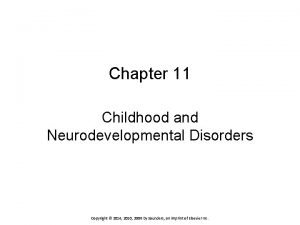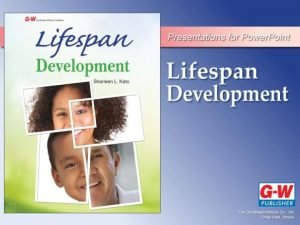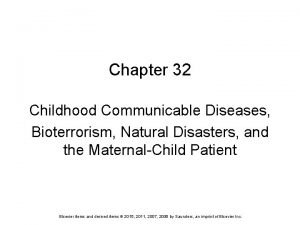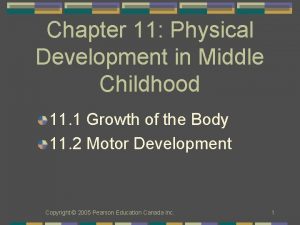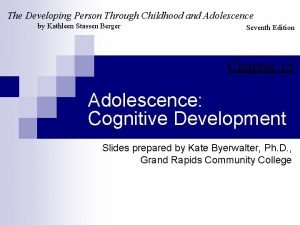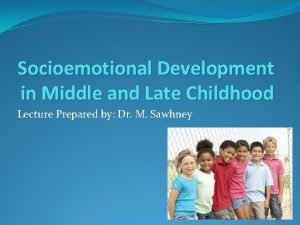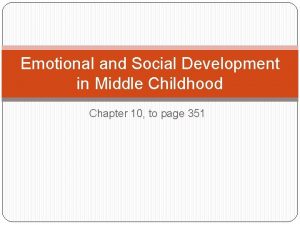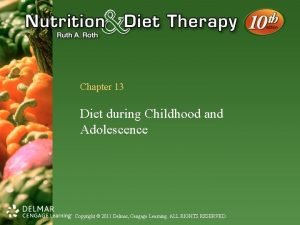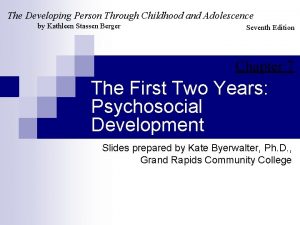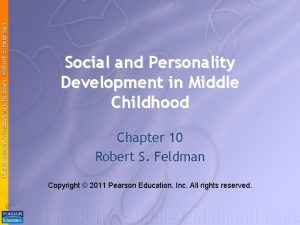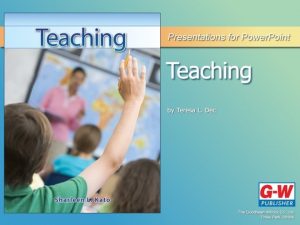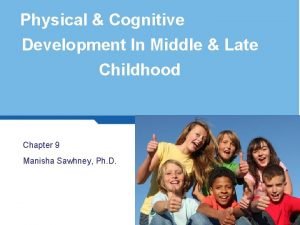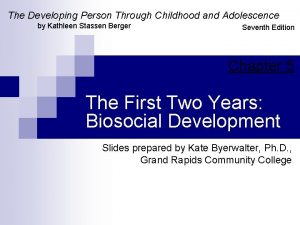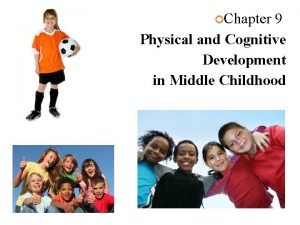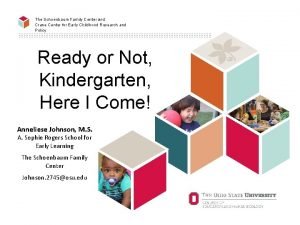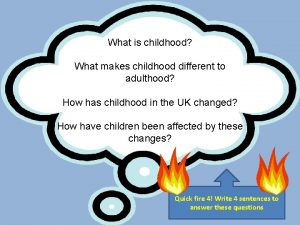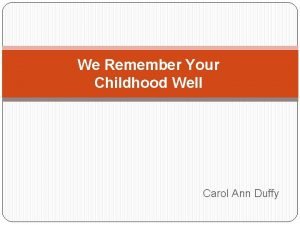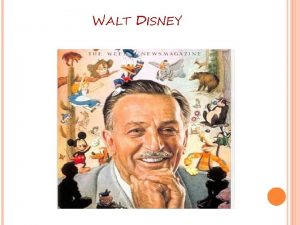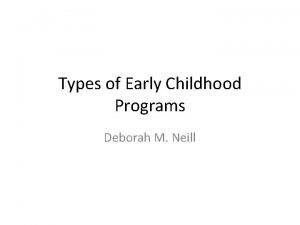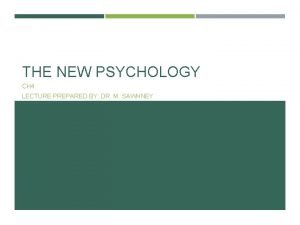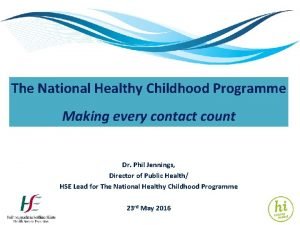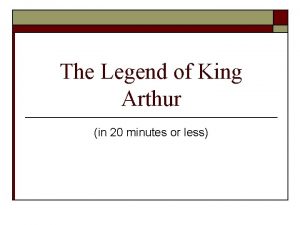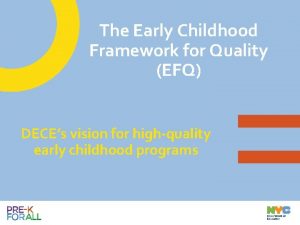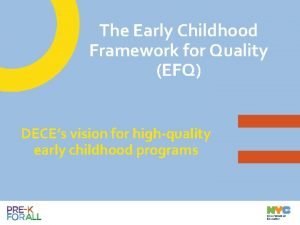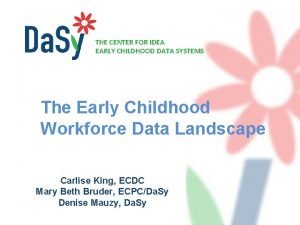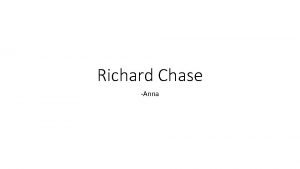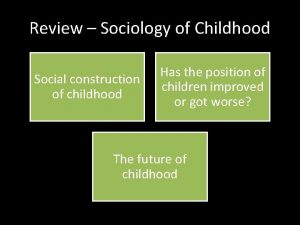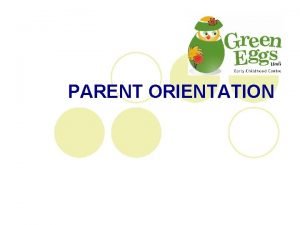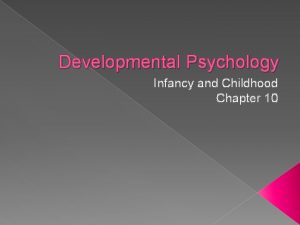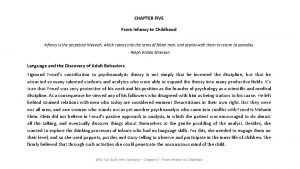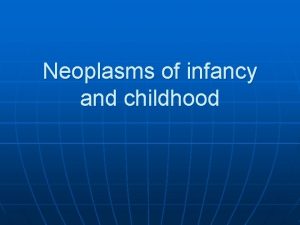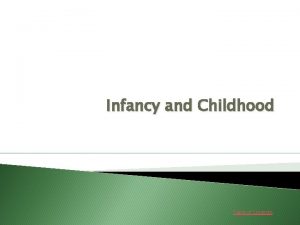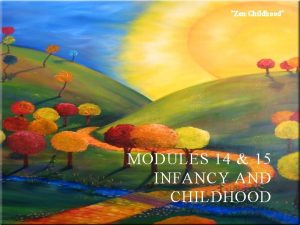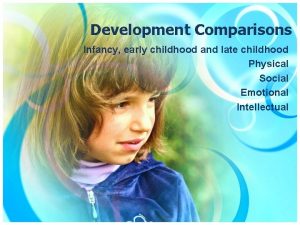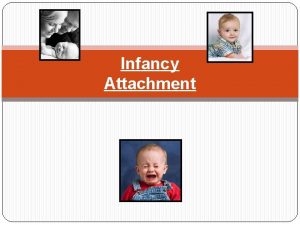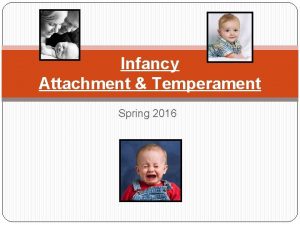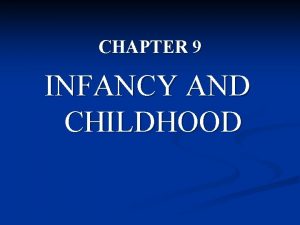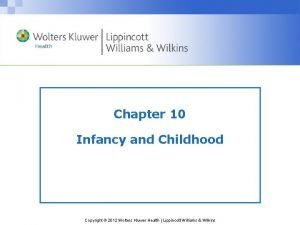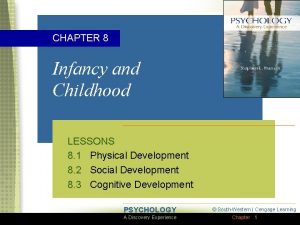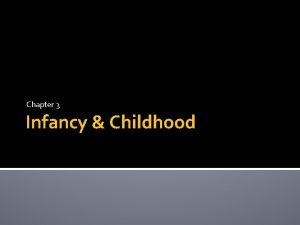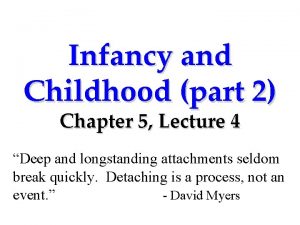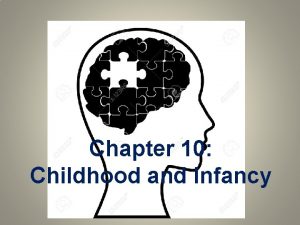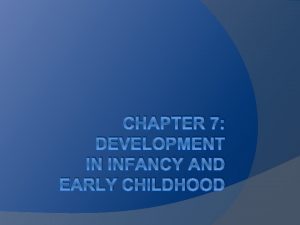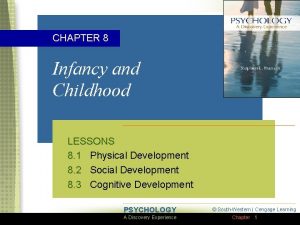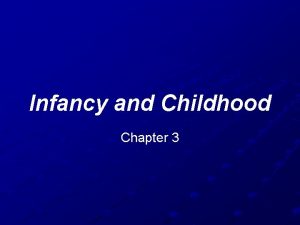Infancy and Childhood Chapter 10 Infancy and Childhood












































































- Slides: 76

Infancy and Childhood Chapter 10: Infancy and Childhood Case Study: Bullying: A Schoolyard Epidemic Section 1: Developmental Psychology Section 2: Physical Development Section 3: Social Development Section 4: Cognitive Development Lab: Applying What You’ve Learned Original Content Copyright by HOLT Mc. Dougal. Additions and changes to the original content are the responsibility of the instructor.

Infancy and Childhood Case Study: Bullying: A Schoolyard Epidemic Bullying has devastating effects. It makes students think of school as a violent environment. Bullying impairs adjustment to middle school and high school. Facts About Bullying • An estimated 70 to 75 percent of students are bullied at some point. • One study found that bullying was more often associated with delinquent behavior, ADHD, and depression. • Many bullies have common characteristics, including lower • Bigger, more physically developed children often bully than average achievement and younger, smaller kids. home environments troubled by violence. Original Content Copyright by HOLT Mc. Dougal. Additions and changes to the original content are the responsibility of the instructor.

Infancy and Childhood What do you think? • How does bullying affect students and the school atmosphere? • Does bullying occur in your school? What can school officials, parents, and students do to limit or stop it? Original Content Copyright by HOLT Mc. Dougal. Additions and changes to the original content are the responsibility of the instructor.

Infancy and Childhood Original Content Copyright by HOLT Mc. Dougal. Additions and changes to the original content are the responsibility of the instructor.

Infancy and Childhood Original Content Copyright by HOLT Mc. Dougal. Additions and changes to the original content are the responsibility of the instructor.

Infancy and Childhood Section 1 at a Glance Developmental Psychology • Developmental psychology is the study of how people grow and change throughout their lives. • Developmental psychologists are concerned with many issues. One issue is the extent to which heredity (nature) and environment (nurture) affect development. Another is whether people develop in distinct stages or whether development is more gradual and steady. Original Content Copyright by HOLT Mc. Dougal. Additions and changes to the original content are the responsibility of the instructor.

Infancy and Childhood Developmental Psychology Main Idea The field of developmental psychology examines physical, social, and cognitive development. Heredity and environment control different aspects of development to varying degrees. Reading Focus • Why and how do psychologists study development? • How do both heredity and environment contribute to the development process? • How would you describe development as a process of stages versus continuity? Original Content Copyright by HOLT Mc. Dougal. Additions and changes to the original content are the responsibility of the instructor.

Infancy and Childhood What can you learn about developmental psychology at the beach? Original Content Copyright by HOLT Mc. Dougal. Additions and changes to the original content are the responsibility of the instructor.

Infancy and Childhood The Study of Development • Developmental psychology is the field in which psychologists study how people grow and change throughout the life span, from conception until death. • Psychologists use two methods to study people across the life span. – The longitudinal method, in which researchers select a group of participants and then observe the same group for a period of time, often years or decades – The cross-sectional method, in which researchers select a sample that includes people of different ages and then compare the participants in the different age groups Original Content Copyright by HOLT Mc. Dougal. Additions and changes to the original content are the responsibility of the instructor.

Infancy and Childhood Reading Check Draw Conclusions What are two reasons that psychologists are interested in studying infancy and childhood? Answer: Early childhood experiences affect people as adolescents and adults, and by studying early stages of development, psychologists can learn about developmental problems. Original Content Copyright by HOLT Mc. Dougal. Additions and changes to the original content are the responsibility of the instructor.

Infancy and Childhood Heredity and Environment • Developmental psychologists are concerned with two general issues: – Ways in which heredity and environmental influences contribute to human development – Whether development occurs gradually or in stages • Psychologists have long debated the extent to which human behavior is determined by heredity (nature) or environment (nurture). • Maturation is the automatic and sequential process of development that results from genetic signals. • A critical period is a stage or point in development during which a person is best suited to learn a particular skill or behavior pattern. • Arnold Gesell proposed that maturation played the most important role in development. John Watson’s view, however, favored the tabula rasa view of development. Original Content Copyright by HOLT Mc. Dougal. Additions and changes to the original content are the responsibility of the instructor.

Infancy and Childhood Original Content Copyright by HOLT Mc. Dougal. Additions and changes to the original content are the responsibility of the instructor.

Infancy and Childhood Reading Check Summarize Name and describe three major issues that are part of the heredity versus environment debate. Answer: maturation, automatic and sequential process of development results from genetic signals; notion of critical periods in development when person is best suited to learn particular skill or behavior; influence of environment, nutrition, family background, culture, learning experiences Original Content Copyright by HOLT Mc. Dougal. Additions and changes to the original content are the responsibility of the instructor.

Infancy and Childhood Stages Versus Continuity • Developmental psychologists debate whether human development occurs primarily in stages or as a continuous process. • Maturational theorists generally believe that most development occurs in stages. • Jean Piaget is one of the most famous stage theorists. • Other psychologists, including J. H. Flavell, argue that cognitive development is a gradual and continuous process. Original Content Copyright by HOLT Mc. Dougal. Additions and changes to the original content are the responsibility of the instructor.

Infancy and Childhood Original Content Copyright by HOLT Mc. Dougal. Additions and changes to the original content are the responsibility of the instructor.

Infancy and Childhood Original Content Copyright by HOLT Mc. Dougal. Additions and changes to the original content are the responsibility of the instructor.

Infancy and Childhood Reading Check Recall Which mode of development (stages or continuity) is more aligned with heredity, and which is more aligned with environment? Answer: heredity—stages, maturation caused by genetic signals; environment—continuous, each advance is based on observation and experience Original Content Copyright by HOLT Mc. Dougal. Additions and changes to the original content are the responsibility of the instructor.

Infancy and Childhood Section 2 at a Glance Physical Development • Children grow physically from the time they are conceived through infancy and childhood. • Reflexes, motor development, and perceptual development are all important aspects of physical development. Original Content Copyright by HOLT Mc. Dougal. Additions and changes to the original content are the responsibility of the instructor.

Infancy and Childhood Physical Development Main Idea In the womb and in infancy and childhood, humans go through a series of physical developments that are generally sequential. Reading Focus • How is physical growth important from conception through childhood? • What are reflexes, and how are they beneficial? • What is motor development? • What do infants learn through the process of perceptual development? Original Content Copyright by HOLT Mc. Dougal. Additions and changes to the original content are the responsibility of the instructor.

Infancy and Childhood How did seat belts highlight differences in physical development? Original Content Copyright by HOLT Mc. Dougal. Additions and changes to the original content are the responsibility of the instructor.

Infancy and Childhood Physical Growth • Changes in reflexes, gains in height and weight, motor development, and perceptual development are examples of physical development. • The most dramatic gains in height and weight occur before an infant’s birth. • During infancy—the period from birth to the age of two years— dramatic gains continue in height and weight. • During childhood—the period from two years old to adolescence— children gain on average two to three inches and four to six pounds each year until they reach the start of adolescence. Original Content Copyright by HOLT Mc. Dougal. Additions and changes to the original content are the responsibility of the instructor.

Infancy and Childhood Original Content Copyright by HOLT Mc. Dougal. Additions and changes to the original content are the responsibility of the instructor.

Infancy and Childhood Reading Check Recall Give three examples of developments that occur during the fetal stage. Answer: During the fourth month, the fetus nearly doubles in length, can open and close its mouth, and swallow. In the next two months, the fetus’s skin finishes developing, hair and nails become visible, and it can open and close its eyes. Original Content Copyright by HOLT Mc. Dougal. Additions and changes to the original content are the responsibility of the instructor.

Infancy and Childhood Reflexes • A reflex is an involuntary reaction or response, such as swallowing. • Reflexes are inborn, not learned, and they occur automatically. • Reflexes include: – Grasping – Rooting – Sucking – Swallowing – The Moro reflex – The Babinski reflex • As children develop, many reflexes, such as rooting and sucking, disappear. Some reflexes remain and others come under voluntary control. Original Content Copyright by HOLT Mc. Dougal. Additions and changes to the original content are the responsibility of the instructor.

Infancy and Childhood Click on the image to play the Interactive. Original Content Copyright by HOLT Mc. Dougal. Additions and changes to the original content are the responsibility of the instructor.

Infancy and Childhood Reading Check Describe How do newborns respond to their environment? Give two examples. Answer: by rooting and sucking and by withdrawing from painful stimuli Original Content Copyright by HOLT Mc. Dougal. Additions and changes to the original content are the responsibility of the instructor.

Infancy and Childhood Motor Development • The development of purposeful movement is called motor development. • Gross motor development refers to babies’ progress in coordinating major muscle groups. • Fine motor development refers to coordination of the hands, face, and other small muscles. • The point at which various types of motor development occur is different from infant to infant and even from culture to culture. Original Content Copyright by HOLT Mc. Dougal. Additions and changes to the original content are the responsibility of the instructor.

Infancy and Childhood Reading Check Identify What are the two types of motor development? Answer: gross motor development and fine motor development Original Content Copyright by HOLT Mc. Dougal. Additions and changes to the original content are the responsibility of the instructor.

Infancy and Childhood Perceptual Development • Infants tend to prefer new and interesting stimuli. • Infants’ perceptual preferences are influenced by their age. • Infants’ depth perception seems to be influenced by experience. Original Content Copyright by HOLT Mc. Dougal. Additions and changes to the original content are the responsibility of the instructor.

Infancy and Childhood Original Content Copyright by HOLT Mc. Dougal. Additions and changes to the original content are the responsibility of the instructor.

Infancy and Childhood Original Content Copyright by HOLT Mc. Dougal. Additions and changes to the original content are the responsibility of the instructor.

Infancy and Childhood Reading Check Recall What elements make up perceptual development? Answer: Physical development and environmental stimuli combine to advance infants’ perceptual development as the infants take in the messages delivered by their senses. Original Content Copyright by HOLT Mc. Dougal. Additions and changes to the original content are the responsibility of the instructor.

Infancy and Childhood Psychology in Today’s World Raising a Better Child In the past, ideas about how to raise children generally came from one’s own family, religion, and other institutions within the community. Beginning around the 1900 s, however, theories of psychologists increasingly began to inform American parenting strategies. Why did parents look beyond traditional sources to learn how to raise their children? • Social upheavals of the last hundred years give clues to the answer. • One popular parenting idea is the “Mozart effect, ” which says that playing Mozart’s music helps boost children’s intelligence. Results have been shown to be limited, however. • Another idea deals with the importance of play. • Some parenting books and theories have more merit than others. Parents need to do their homework when looking for help with their kids. Original Content Copyright by HOLT Mc. Dougal. Additions and changes to the original content are the responsibility of the instructor.

Infancy and Childhood Original Content Copyright by HOLT Mc. Dougal. Additions and changes to the original content are the responsibility of the instructor.

Infancy and Childhood Thinking Critically • What does the large number of child-rearing books suggest about the challenges that parents face? • How do you think the ways that you played as a child have affected you? Original Content Copyright by HOLT Mc. Dougal. Additions and changes to the original content are the responsibility of the instructor.

Infancy and Childhood Section 3 at a Glance Social Development • Through the process of social development, infants and children learn to relate to other people. • Attachment bonds infants and children to those close to them, and the quality of this attachment affects how they develop. • Parenting styles cover a wide range, but some styles are more likely to produce well-adjusted children who place a high value on themselves. The value one places on one’s self is called self-esteem. Original Content Copyright by HOLT Mc. Dougal. Additions and changes to the original content are the responsibility of the instructor.

Infancy and Childhood Social Development Main Idea Social development in infants and children has much to do with parents’ behaviors, histories, personalities, and abilities. Other caregivers are involved in raising many American children. Reading Focus • Why is attachment vital to human relationships? • How do styles of parenting differ? • What are some issues associated with child abuse and neglect? • How does outside child care affect children's development? • What is the importance of self-esteem to developing children? Original Content Copyright by HOLT Mc. Dougal. Additions and changes to the original content are the responsibility of the instructor.

Infancy and Childhood What can baby cranes tell us about social development? Original Content Copyright by HOLT Mc. Dougal. Additions and changes to the original content are the responsibility of the instructor.

Infancy and Childhood Attachment is an important factor affecting social development. It is defined as the emotional ties that form between people. Development of Attachment Contact Comfort • Up until four months of age, infants prefer being held or even just being with someone. • Based on studies with monkeys, researchers have concluded that attachment grows more from contact comfort than from feeding. • By about four months, infants develop strong attachments to their main caregivers, usually their mothers. • By about eight months, some infants develop stranger anxiety and separation anxiety. • Bonds of attachment between mothers and infants appear to provide a secure base from which infants can explore their environments. Original Content Copyright by HOLT Mc. Dougal. Additions and changes to the original content are the responsibility of the instructor.

Infancy and Childhood Imprinting • For many animals, attachment is an instinct. • In a process called imprinting, some animals become attached to the first moving object they see. • Children do not imprint. It takes several months before children become attached to their main caregivers. Secure Versus Insecure Attachment • When mothers or other primary caregivers are affectionate and reliable, infants usually become securely attached. • When caregivers are unresponsive or unreliable, infants are usually insecurely attached. • Secure infants may mature into secure children. Original Content Copyright by HOLT Mc. Dougal. Additions and changes to the original content are the responsibility of the instructor.

Infancy and Childhood Autism • Autism is a developmental disorder that prevents children from forming proper attachments with others. • People with autism have a very wide variety of symptoms from very severe to very subtle. Mild autism can go undiagnosed for years. • Parents and doctors often recognize symptoms of autism during infancy and early childhood. Original Content Copyright by HOLT Mc. Dougal. Additions and changes to the original content are the responsibility of the instructor.

Infancy and Childhood Original Content Copyright by HOLT Mc. Dougal. Additions and changes to the original content are the responsibility of the instructor.

Infancy and Childhood Original Content Copyright by HOLT Mc. Dougal. Additions and changes to the original content are the responsibility of the instructor.

Infancy and Childhood Reading Check Define What is contact comfort and how does it relate to the idea of attachment? Answer: Contact comfort is an instinctual need to touch and be touched by something soft. It was originally thought that infants became attached to those who fed them, but recent findings indicate that attachment grows more from such bodily contact. Original Content Copyright by HOLT Mc. Dougal. Additions and changes to the original content are the responsibility of the instructor.

Infancy and Childhood Styles of Parenting Warm or Cold? Strict or Permissive? • Warm parents show a great deal of affection to their children. • Some parents are strict with their children, imposing many rules and supervising their children closely. • Cold parents may not be as affectionate toward their children or appear to enjoy them as much. • Research suggests that children fare better when their parents are warm to them. • Children of warm parents are more likely to be well adjusted. • Some parents are permissive with their children, imposing fewer rules and watching their children less closely. • Authoritative parents combine warmth with age appropriate rules and responsibilities. • Authoritarian parents believe in obedience for its own sake. Original Content Copyright by HOLT Mc. Dougal. Additions and changes to the original content are the responsibility of the instructor.

Infancy and Childhood Original Content Copyright by HOLT Mc. Dougal. Additions and changes to the original content are the responsibility of the instructor.

Infancy and Childhood Reading Check Describe Can a parent be warm but strict or cold but permissive? Explain how parenting styles can be a mix of things. Answer: Yes. Parents can be strict but still love their children. Authoritative parents combine warmth with age-appropriate rules and responsibilities, whereas authoritarian parents are cold and rejecting, and value obedience for its own sake. Original Content Copyright by HOLT Mc. Dougal. Additions and changes to the original content are the responsibility of the instructor.

Infancy and Childhood Original Content Copyright by HOLT Mc. Dougal. Additions and changes to the original content are the responsibility of the instructor.

Infancy and Childhood Child Abuse and Neglect • Most parents are kind and loving to their children. • Yet child abuse is relatively widespread and seriously underreported. • The following factors are associated with child abuse and neglect: – Stress, especially from unemployment or poverty – A history of physical or sexual abuse in at least one parent’s family – Acceptance of violence as a way of coping with stress – Lack of attachment to the child – Substance abuse – Rigid attitudes about child rearing • Studies show that children who are abused run a higher risk of developing psychological problems. • Child abuse tends to run in families. Original Content Copyright by HOLT Mc. Dougal. Additions and changes to the original content are the responsibility of the instructor.

Infancy and Childhood Reading Check Describe Why is a parent with a history of child abuse in his or her own family more likely to become a child abuser? Answer: Children who have been abused are more likely to act in violent ways; they may imitate their parents’ behavior, or they may adopt their parents’ strict ideas about discipline. Original Content Copyright by HOLT Mc. Dougal. Additions and changes to the original content are the responsibility of the instructor.

Infancy and Childhood Child Care • Most American parents work outside the home and more than half of mothers of children younger than one year of age are working mothers. • Millions of preschoolers are cared for in day-care facilities. • Studies of the effects of day care on parent-child attachments have shown mixed results. • Day care seems to have mixed effects on other aspects of children’s social development. • The quality of care seems to be more important than who provides it. Original Content Copyright by HOLT Mc. Dougal. Additions and changes to the original content are the responsibility of the instructor.

Infancy and Childhood Original Content Copyright by HOLT Mc. Dougal. Additions and changes to the original content are the responsibility of the instructor.

Infancy and Childhood Reading Check Recall Explain why the effects of day care on children are said to be mixed. Answer: partly because of the differences in quality of care provided in different day-care centers, and partly because psychologists have interpreted the same phenomena in different ways Original Content Copyright by HOLT Mc. Dougal. Additions and changes to the original content are the responsibility of the instructor.

Infancy and Childhood Self-Esteem Self-esteem, the value or worth that people attach to themselves, begins to develop in early childhood. Influences on Self-Esteem Gender and Self-Esteem • Secure attachment plays a major role in influencing self-esteem. • Girls tend to display greater competence in reading and general academic skills and boys tend to display competence in math and physical skills. • Another influence is how parents react to their children. • Children who receive unconditional positive regard usually develop high self-esteem. • Children who receive conditional positive regard may have lower self-esteem. • This may be because this is what girls and boys are supposed to be good at. • It is not for a genetic reason. Original Content Copyright by HOLT Mc. Dougal. Additions and changes to the original content are the responsibility of the instructor.

Infancy and Childhood Age and Self-Esteem • Although children gain in competence as they grow older, their selfesteem tends to decline during the elementary school years. • It seems to reach a low point at about age 12 or 13 and increases again during adolescence. The Self-Esteem Trap • By the 1970 s, greater self-esteem was thought of by many as a potential cure-all for society’s problems. Showering children with praise regardless of their performance was the common practice. • Findings in 2000 showed that high self-esteem in children did not lead to higher grades and that high self-esteem did not make violent kids any less so or keep kids from becoming bullies. • Focusing on building self-esteem at the expense of other qualities, such as self-control or self-discipline, may be misguided. Original Content Copyright by HOLT Mc. Dougal. Additions and changes to the original content are the responsibility of the instructor.

Infancy and Childhood Reading Check Recall When and how does a person’s sense of self-esteem develop? Answer: It begins to develop in early childhood. It is influenced by the way parents react to their children and by fostering a sense of competence. Original Content Copyright by HOLT Mc. Dougal. Additions and changes to the original content are the responsibility of the instructor.

Infancy and Childhood Current Research in Psychology Inside the Autistic Mind People with autism have a difficult road in life. The list of possible problems associated with autism is long and troubling. Recent research is looking deep into the brains of people with autism to help explain and attempt to deal with the condition. • Researchers are observing brain activity in mother-child pairs where the child has autism in order to learn about differences in brain functions in people with autism versus people without autism. • Other research focuses on the study of mirror neurons. • Studies of the mirror neuron systems of people with autism show that they responded when they performed an activity, but not when they observed it. • These two areas of research may help doctors diagnose autism earlier and help in the development of treatments. Original Content Copyright by HOLT Mc. Dougal. Additions and changes to the original content are the responsibility of the instructor.

Infancy and Childhood Original Content Copyright by HOLT Mc. Dougal. Additions and changes to the original content are the responsibility of the instructor.

Infancy and Childhood Thinking Critically • Why do you think the mothers are involved in the first study described? • Why do you think mirror neuron problems lead to empathy and language shortcomings? Original Content Copyright by HOLT Mc. Dougal. Additions and changes to the original content are the responsibility of the instructor.

Infancy and Childhood Section 4 at a Glance Cognitive Development • Cognitive development is the development of people’s thought processes. • The psychologist Jean Piaget divided cognitive development into four stages: the sensorimotor stage, the preoperational stage, the concrete-operational stage, and the formal-operational stage. • The psychologist Lawrence Kohlberg’s theory of moral development has three stages: the preconventional level, the conventional level, and the postconventional level. Each of these three levels is further divided into two levels. Original Content Copyright by HOLT Mc. Dougal. Additions and changes to the original content are the responsibility of the instructor.

Infancy and Childhood Cognitive Development Main Idea The study of cognitive development looks at how people’s thought processes change and evolve over time. Jean Piaget and Lawrence Kohlberg are two influential theorists in this area. Reading Focus • What are the stages of Piaget’s theory of cognitive development? • How did Kohlberg use a moral dilemma to illustrate his theory of moral development? Original Content Copyright by HOLT Mc. Dougal. Additions and changes to the original content are the responsibility of the instructor.

Infancy and Childhood Have you ever spent some quality time with a five-year-old? Original Content Copyright by HOLT Mc. Dougal. Additions and changes to the original content are the responsibility of the instructor.

Infancy and Childhood Piaget’s Theory of Cognitive Development Assimilation and Accommodation • Piaget believed that human beings use assimilation and accommodation to organize new information. • Assimilation is the process by which new information is placed into categories that already exist. • Accommodation is change brought about by new information. The Sensorimotor Stage • The first stage of cognitive development is the sensorimotor stage. • This stage is characterized by learning to coordinate sensation and perception with motor activity. • It is also characterized by object permanence. Original Content Copyright by HOLT Mc. Dougal. Additions and changes to the original content are the responsibility of the instructor.

Infancy and Childhood Original Content Copyright by HOLT Mc. Dougal. Additions and changes to the original content are the responsibility of the instructor.

Infancy and Childhood The Preoperational Stage • The next stage is the preoperational stage. • It is characterized by one-dimensional thinking and egocentrism. The Concrete-Operational Stage • In the concrete-operational stage, children begin to show signs of adult thinking. • They are logical only when they think about specific objects and concrete experiences. • They focus on two dimensions of a problem at the same time. • They are less egocentric than children in earlier stages. Original Content Copyright by HOLT Mc. Dougal. Additions and changes to the original content are the responsibility of the instructor.

Infancy and Childhood The Formal-Operational Stage • The final stage in Piaget’s theory is the formal-operational stage. • People in this stage think abstractly. • They can deal with hypothetical situations. • They can solve problems and use imagination. Criticism of Piaget’s Theories • Some psychologists have questioned the accuracy of Piaget’s views. • Recent research indicates that preschoolers are less egocentric than Piaget’s research suggested. • His theories are still respected, however. Original Content Copyright by HOLT Mc. Dougal. Additions and changes to the original content are the responsibility of the instructor.

Infancy and Childhood Original Content Copyright by HOLT Mc. Dougal. Additions and changes to the original content are the responsibility of the instructor.

Infancy and Childhood Reading Check Recall What are the stages of Piaget’s theory of cognitive development? Answer: Sensorimotor Stage, Preoperational Stage, Concrete-Operational Stage, Formal-Operational Stage Original Content Copyright by HOLT Mc. Dougal. Additions and changes to the original content are the responsibility of the instructor.

Infancy and Childhood Kohlberg’s Theory of Moral Development The Preconventional Level The Conventional Level • Children through the age of nine use preconventional moral reasoning to base their judgments of the consequences of behavior. • People at this level use conventional moral reasoning to make judgments in terms of whether an act conforms to conventional standards of behavior. The Postconventional Level Bias in Kohlberg’s Theory • Reasoning based on a person’s own moral standards of goodness is called postconventional moral reasoning. • Kohlberg’s stages and scoring system may have been biased to favor males. Original Content Copyright by HOLT Mc. Dougal. Additions and changes to the original content are the responsibility of the instructor.

Infancy and Childhood Original Content Copyright by HOLT Mc. Dougal. Additions and changes to the original content are the responsibility of the instructor.

Infancy and Childhood Original Content Copyright by HOLT Mc. Dougal. Additions and changes to the original content are the responsibility of the instructor.

Infancy and Childhood Reading Check Describe How does moral reasoning change throughout Kohlberg’s stages? Answer: People evolve from self-preservation (avoiding punishment) to operating under the dictates of their own consciences. Original Content Copyright by HOLT Mc. Dougal. Additions and changes to the original content are the responsibility of the instructor.

Infancy and Childhood Lab: Applying What You’ve Learned Prenatal and Postnatal Development How do fetuses and infants develop in the United States and in other parts of the world? 1. Introduction 2. Form Groups and Research • You will be assigned to one of two groups. • Group A will organize itself into three teams. Each team will research a different trimester of prenatal development. • Group A will research prenatal physical development. • Group B will research postnatal physical development. • Each group will give an oral presentation of their findings. • Group B should organize itself into four teams. Each team will research a six-month period of the first two years of postnatal development. Original Content Copyright by HOLT Mc. Dougal. Additions and changes to the original content are the responsibility of the instructor.

Infancy and Childhood Lab (cont'd. ) 3. Research International Issues 4. Organize Your Findings and Give Your Presentation • Each Group A team will research a health care issue or social problem that affects fetal development in another country. • Work as a team to organize your information into an oral presentation. • Group B will research cultural differences in motor development. Each Group B team will find a country where children develop differently. • The presentation should be under five minutes. • Several members should act as speakers. Original Content Copyright by HOLT Mc. Dougal. Additions and changes to the original content are the responsibility of the instructor.

Infancy and Childhood Lab (cont'd. ) 5. Discussion • What surprised you most about prenatal development? • Which issue that affects unborn children in different countries concerned you the most? Why? • Which age period of motor development did you find most interesting? Why? • Did any of the international differences in motor development come as a surprise to you? Explain. Original Content Copyright by HOLT Mc. Dougal. Additions and changes to the original content are the responsibility of the instructor.

Infancy and Childhood Original Content Copyright by HOLT Mc. Dougal. Additions and changes to the original content are the responsibility of the instructor.
 Middle childhood years
Middle childhood years Chapter 10 infancy and childhood
Chapter 10 infancy and childhood Chapter 10 infancy and childhood review worksheet answers
Chapter 10 infancy and childhood review worksheet answers Psychology chapter 10 infancy and childhood
Psychology chapter 10 infancy and childhood Social development in infancy and childhood
Social development in infancy and childhood Module 47 infancy and childhood cognitive development
Module 47 infancy and childhood cognitive development Infancy and childhood psychology
Infancy and childhood psychology Infancy and childhood physical development
Infancy and childhood physical development Lesson quiz 3-2 infancy and childhood
Lesson quiz 3-2 infancy and childhood Rovee-collier
Rovee-collier Module 47 infancy and childhood cognitive development
Module 47 infancy and childhood cognitive development Infancy childhood adolescence adulthood old age
Infancy childhood adolescence adulthood old age Chapter 5 cognitive development in infancy and toddlerhood
Chapter 5 cognitive development in infancy and toddlerhood Emotional development is often stormy and in conflict
Emotional development is often stormy and in conflict Intellectual in health and social care
Intellectual in health and social care Infancy period
Infancy period Socioemotional development in infancy
Socioemotional development in infancy Chapter 7 human growth and development
Chapter 7 human growth and development Growth and development stages
Growth and development stages Infancy
Infancy Personality development in infancy
Personality development in infancy Infancy physical changes
Infancy physical changes Infant personality development
Infant personality development Catastrophic epilepsy infancy
Catastrophic epilepsy infancy Stages of socialization
Stages of socialization Pies in infancy
Pies in infancy Pavlik harness
Pavlik harness New emotions that appear toward the second year
New emotions that appear toward the second year Infancy
Infancy Messianic prophecies fulfilled in the infancy narratives
Messianic prophecies fulfilled in the infancy narratives Chapter 11 childhood and neurodevelopmental disorders
Chapter 11 childhood and neurodevelopmental disorders Types of early childhood programs chapter 2
Types of early childhood programs chapter 2 Frankenstein summary
Frankenstein summary Chapter 7 early childhood ages 3 through 5 answer key
Chapter 7 early childhood ages 3 through 5 answer key Chapter 32 childhood communicable diseases bioterrorism
Chapter 32 childhood communicable diseases bioterrorism What is the first sad memory of young jose
What is the first sad memory of young jose Early childhood is __________ for language learning
Early childhood is __________ for language learning Physical development in middle childhood chapter 11
Physical development in middle childhood chapter 11 The boy in the striped pyjamas film analysis
The boy in the striped pyjamas film analysis Adolescent egocentrism
Adolescent egocentrism Centration
Centration Late childhood socioemotional development
Late childhood socioemotional development Ecetp.pdp.albany.edu.elearning
Ecetp.pdp.albany.edu.elearning Early childhood directorate
Early childhood directorate Middle and late childhood
Middle and late childhood Social and emotional development in middle childhood
Social and emotional development in middle childhood Eating a balanced diet during childhood and adolescence
Eating a balanced diet during childhood and adolescence The developing person through childhood and adolescence
The developing person through childhood and adolescence Damon's stages of friendship
Damon's stages of friendship Middle childhood growth and development
Middle childhood growth and development Late childhood physical development
Late childhood physical development Jesus birth and childhood
Jesus birth and childhood Transient exuberance definition
Transient exuberance definition Middle and late childhood
Middle and late childhood Childhood rivalry in bali and new guinea
Childhood rivalry in bali and new guinea The crane center ohio
The crane center ohio William shakespeare childhood
William shakespeare childhood Social construction of childhood
Social construction of childhood Carol ann duffy we remember your childhood well
Carol ann duffy we remember your childhood well Walt disneys childhood
Walt disneys childhood Three types of early childhood programs
Three types of early childhood programs Structuralism in psychology
Structuralism in psychology The national healthy childhood programme
The national healthy childhood programme King arthur childhood
King arthur childhood Efq
Efq Efq
Efq Childhood age range
Childhood age range Yor childhood
Yor childhood Lonnie franklin jr
Lonnie franklin jr Marybeth tinning tami lynne tinning
Marybeth tinning tami lynne tinning Rihana real name
Rihana real name Vampire the richard chase murders
Vampire the richard chase murders Social construction of childhood
Social construction of childhood Queen elizabeth 1 childhood
Queen elizabeth 1 childhood Percy bysshe shelley childhood
Percy bysshe shelley childhood Welcome dear parents
Welcome dear parents Define childhood obesity
Define childhood obesity




